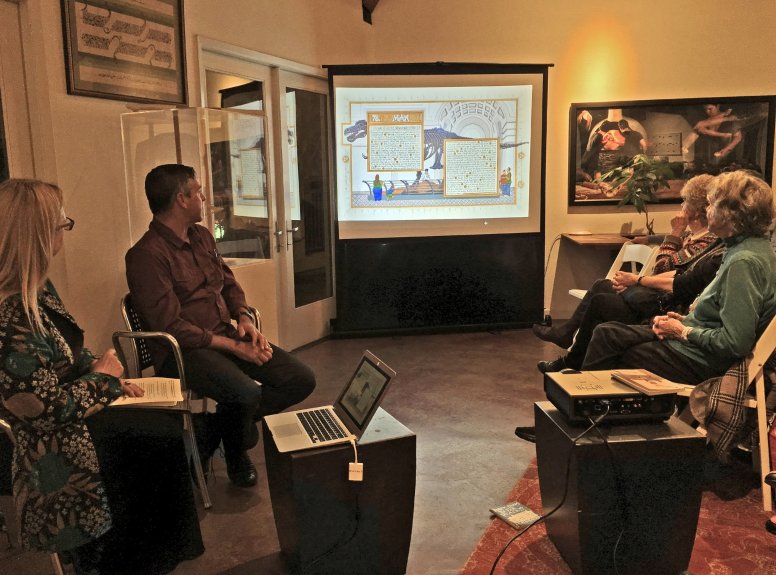By Khalida Sarwari
Picking up a book and reading it isn’t enough for Sandow Birk. To make sense of a text, the Los Angeles-based artist delves into it in a way only he knows how.
And so to understand the Quran—the central text of Islam and arguably one of the most misunderstood books in the world—Birk spent nine years creating an illustrated manuscript of the Quran in English by hand.
Titled “American Qur’an,” Birk’s work draws parallels between Islamic traditions and contemporary American life, reflecting themes and depictions of inner city violence, graffiti, travel, war, prisons and even surfing and skateboarding. For example, he weaves a story about Noah’s Ark with depictions of hurricane-ravaged New Orleans. As he explained at a discussion recently at the Montalvo Arts Center in Saratoga, “it’s not easy to imagine the whole world being wiped out, but it is easy to imagine New Orleans” in the aftermath of Hurricane Katrina.
A non-religious person, Birk said his intention was to make the book as accessible to Americans as the Bible. Both offer similar lessons and stories, he said, but while one is treated with reverence, the other is feared and misunderstood. To Birk, many Americans tend to have the conception that the Quran is “this crazy, foreign incomprehensible thing.”
To bridge that divide, he spent years reading and reflecting on the themes within the text and connecting them to modern life in the United States. A passage in the Quran about God sending down rain to sustain the crops, for example, is set against a canvas depicting people shopping at a supermarket. Passages pertaining to Job, a prophet in all three Abrahamic religions, is set against imagery of Mexican natives attempting to sneak across the border into Arizona. A verse about the virtues of being good and having to be subjected to final judgement is contemporized in an image of a prison scene.
“I found the Quran to be fascinating, even as a non-religious person,” Birk told Lori Wood, moderator of a conversation with the artist at Montalvo on Nov. 22. “It’s fascinating as a book, it’s fascinating as a historical object. Every day I would wake up and I would learn something new.”
He said he was inspired to delve into the Quran shortly after the 9-11 terrorist attacks. He had just completed a project on the Iraq War, and he had visited and gone surfing in many of the Islamic countries at the center of national discussions pertaining to Islam and the conflict between East and West. He said he found them to be different than the way they were being portrayed by the media.
“I thought, I’ve been to so many Islamic countries for surfing; nothing going on in the discourse in American radio is like the Islam that I know firsthand,” he said. “I was sick of the people on the radio telling me what Islam was about, and so I picked up the book to find out for myself.”
He said he approached the book, which has 114 chapters of varying lengths, by tuning out everything he knew about it and taking it at face value. He also drew inspiration from the street graffiti culture in Los Angeles, using a modified version as a font for “American Qur’an.”
Praising his “patience, perseverance and discipline,” Wood compared Birk’s work to “a durational performance piece” and asked him what it was like to sit at his desk for thousands of hours to work on the project. It wasn’t always easy, admitted Birk, explaining that one of the biggest challenges was sustaining his motivation to complete the book.
“That’s the life of an artist, no matter what you’re doing,” he said.
Asked if he was ever concerned about opening himself up to death threats following the controversy in 2005 over Danish newspaper Jyllands-Posten publishing editorial cartoons depicting Muhammad, the principal figure of Islam, Birk said while he is somewhat worried, his belief in himself as an artist and his purpose behind the project is stronger. “On the one hand, I am reverential to the Quran, but on the other hand, I’m an American from Los Angeles,” he said.
Critical assessments of his book have been mostly positive.
Birk “is paying close, complicated attention to what may be the single most important, and least understood, book in the world at present,” Holland Cotter, an art critic for the New York Times, stated in his review of “American Qur’an.”
Birk told a 40-member audience at Montalvo it was for this reason that he started working on the Quran project.
“The Quran is probably the most important work in the last 20 years, for better or worse, due to politics, due to wars, and for us in America to not know what is in it is a shame,” he said.
“American Qur’an” isn’t Birk’s first large-scale project. He previously spent five years illustrating and translating the 14,000 lines of Dante’s “Divine Comedy.” He employs the same model in that book, juxtaposing images of modern American life against an adaptation of Dante’s epic poem into contemporary slang.
The book is available on Amazon. Bay Area residents have an opportunity to see Birk’s works at a couple of local galleries. They are part of an exhibition at the San Jose Museum of Art titled “Indestructible Wonder.” The exhibit runs through Jan. 29. The Thacher Gallery at the University of San Francisco is also showing his art as part of an exhibit that runs through Feb. 19, titled “The Depravities of War.”
To learn more about Birk, visit his website at sandowbirk.com.
Link: Artist’s book bridges divide between Quran and how it’s viewed
